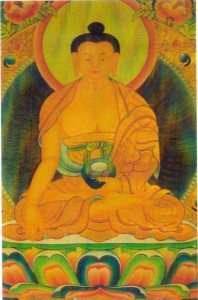Shakyamuni Buddha
Shakymuni Buddha was born a prince in Lumbini, Nepal, at the foot of Mount Palpa in the Himalayan ranges, in 560 B.C. He died at age 80 in 480 B.C. His father was Suddhodana, king of the Sakhyas. Because his mother, Maya, died seven days after his birth, he was raised by his foster mother, Maya’s sister Mahaprajapati.
Siddhartha means “one who has accomplished his aim.” Gautama was Siddhartha’s family name. He was also known as Sakhya Muni, meaning an ascetic of the Sakhya tribe.
Upon his birth, astrologers predicted that upon achieving manhood, Siddhartha would become either a universal monarch (Chakravarti), or would abandon all earthly comforts to become a monk and a Buddha, a perfectly enlightened soul who would then assist all mankind to achieve enlightenment. His father, who desired his son to become a universal monarch, asked the astrologers what his son would see that might cause him to retire from the world. They replied: “A decrepit old man, a diseased man, a dead man and a monk.”
Doing his best to prevent his son from becoming a monk, Suddhodana raised him in luxury and indulgence and sought to keep him attached to sensual pleasure.
Guards were posted to assure that Siddhartha did not make contact with the four men described by the astrologers. He placed his son in a magnificent walled estate with gardens, fountains, palaces, music, dancing and beautiful women. Siddhartha married Yasodhara at age sixteen, who subsequently gave birth to their son, Rahula. Throughout these early years of his life, he knew nothing of the sufferings that were taking place outside his enclosure.
![mandala[1]](http://shakyamuni.net/wp-content/uploads/2011/03/mandala1-150x150.jpg)
The Wheel of Existence
Siddhartha left his home forever, donning yellow robes and shaving his head, to take up Yogic practices. Seeking instruction from several hermit teachers who lived in caves in the neighboring hills, he practiced severe Tapas (austerities) and Pranayama (breath control) for six years, during which time he almost starved to death and became exceedingly weak. He finally realized that starvation did not serve his aims, as it would lead to the very conditions he was trying to surmount. At this point he decided to give up the extreme life he had been living, eat food in moderation, and take to the “middle path.”
Given food by a young woman, he sought a comfortable place to sit and eat it. He found a large tree, now known as the great Bo-tree, or Tree of Wisdom. Upon consuming the physical food, he realized that he was starved for spiritual nourishment. Going deep into meditation, he contemplated his journey with its temptations and desires but did not yield to them. The legends tell us that he came out of the meditation victorious, his face shining with illumination and splendor, having attained Nirvana. (Nirvana is the completion of the path of Buddhism in which the person has achieved self-enlightenment and all delusion and anguish are permanently ended). He got up and danced in divine ecstasy for seven days and nights around the sacred Bo-tree, after which he returned to a normal state of consciousness filled with incredible compassion for all. He had an overwhelming desire to share his illumination with humanity.
Thus at age 35, Siddhartha was a Boddhisatva (one who has achieved enlightenment but chooses to remain in this world who help those who are suffering). He expressed the experience of his Samadhi (state of consciousness in which Absoluteness is experienced attended with all-knowledge and joy; Oneness): “I thus behold my mind released from the defilement of sensual pleasures, released from the defilement of heresy, released from the defilement of ignorance.”
“The Buddha” (enlightened one) left his wondrous Bo-tree behind, venturing out into the world to teach others who were seeking Wisdom and Enlightenment. The subsequent teachings of The Buddha are the foundation of Buddhism.


